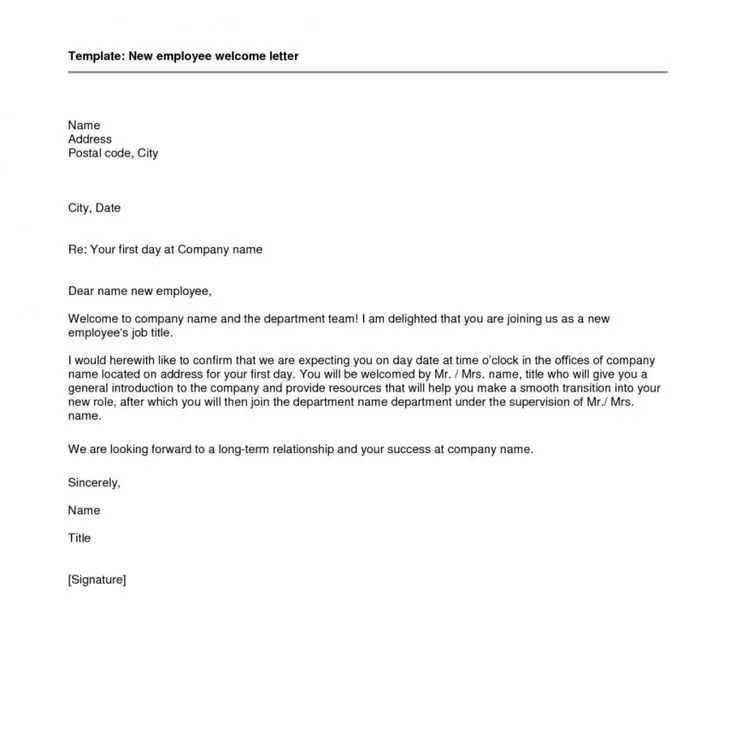Why Cover Letters Matter
In the competitive job market, a well-crafted cover letter can be your secret weapon. It’s more than just a formality it is your first opportunity to make a strong impression on a potential employer and distinguish yourself from other applicants. A cover letter provides a platform to showcase your personality, articulate your passion for the role, and highlight why your skills and experience align with the company’s needs. Resumes provide the facts, but cover letters tell the story, explaining why you are the ideal candidate. Cover letters allow you to expand on your resume, elaborate on your accomplishments, and address any potential concerns an employer might have, such as gaps in your employment history or a career change. They demonstrate your communication skills, attention to detail, and genuine interest in the position. By carefully tailoring your cover letter to each job application, you significantly increase your chances of getting noticed and landing an interview.
Crafting a Compelling Cover Letter
Crafting a compelling cover letter requires more than just rehashing your resume. It’s about presenting yourself in the best possible light and captivating the reader from the start. The key is to be specific, enthusiastic, and focused on how you can contribute to the company’s success. A compelling cover letter is clear, concise, and tailored to each specific job application. It should demonstrate your understanding of the role, your relevant skills, and your genuine interest in the company. Show, don’t just tell. Instead of simply stating that you’re a team player, provide a specific example of how you collaborated with others to achieve a goal. Use action verbs to describe your accomplishments and quantify your results whenever possible. Remember to keep your cover letter focused on the employer’s needs. Show how you can solve their problems and add value to their organization. By doing so, you’ll create a compelling narrative that grabs their attention and makes them want to learn more about you.
The Structure of a Winning Cover Letter
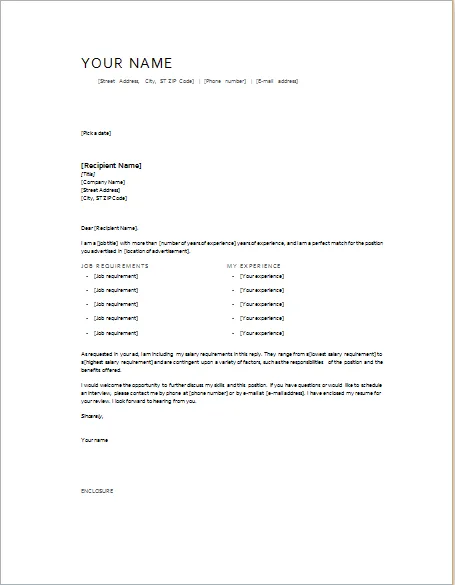
A well-structured cover letter is crucial for making a positive impression. A clear and organized format helps the hiring manager quickly grasp your key qualifications and understand why you’re a good fit for the role. Each part of the cover letter serves a specific purpose and contributes to the overall message. This structure includes contact information, a professional greeting, a captivating opening paragraph, a section highlighting skills and experience, a paragraph dedicated to addressing salary requirements (when necessary), an enthusiastic closing paragraph, and a professional closing. Each section of the cover letter must be carefully crafted to align with the job description and the company’s values. By following a clear structure, you demonstrate your professionalism and make it easy for the hiring manager to find the information they need.
Your Contact Information
At the top of your cover letter, include your full name, address, phone number, and professional email address. This information ensures that the hiring manager can easily reach you. Make sure that the email address you use is professional and appropriate. Avoid using nicknames or informal language in your email address. Ensure your phone number is correct, and consider setting up a professional voicemail greeting. Double-check all the information to avoid errors, as a simple typo can lead to missed opportunities. A well-presented contact section is the first step in making a positive impression.
The Greeting
The greeting sets the tone for your cover letter. Always address the hiring manager by name, if possible. Research the company website, LinkedIn, or other sources to find the name of the hiring manager or the appropriate contact person. If you cannot find a specific name, use a professional salutation, such as ‘Dear Hiring Manager’ or ‘Dear [Department Name] Team’. Avoid generic greetings like ‘To Whom It May Concern,’ which can come across as impersonal. Using the hiring manager’s name shows that you have taken the time to research the company and are genuinely interested in the position. This personalized approach helps to build a connection and immediately captures their attention.
Opening Paragraph: Grab Their Attention
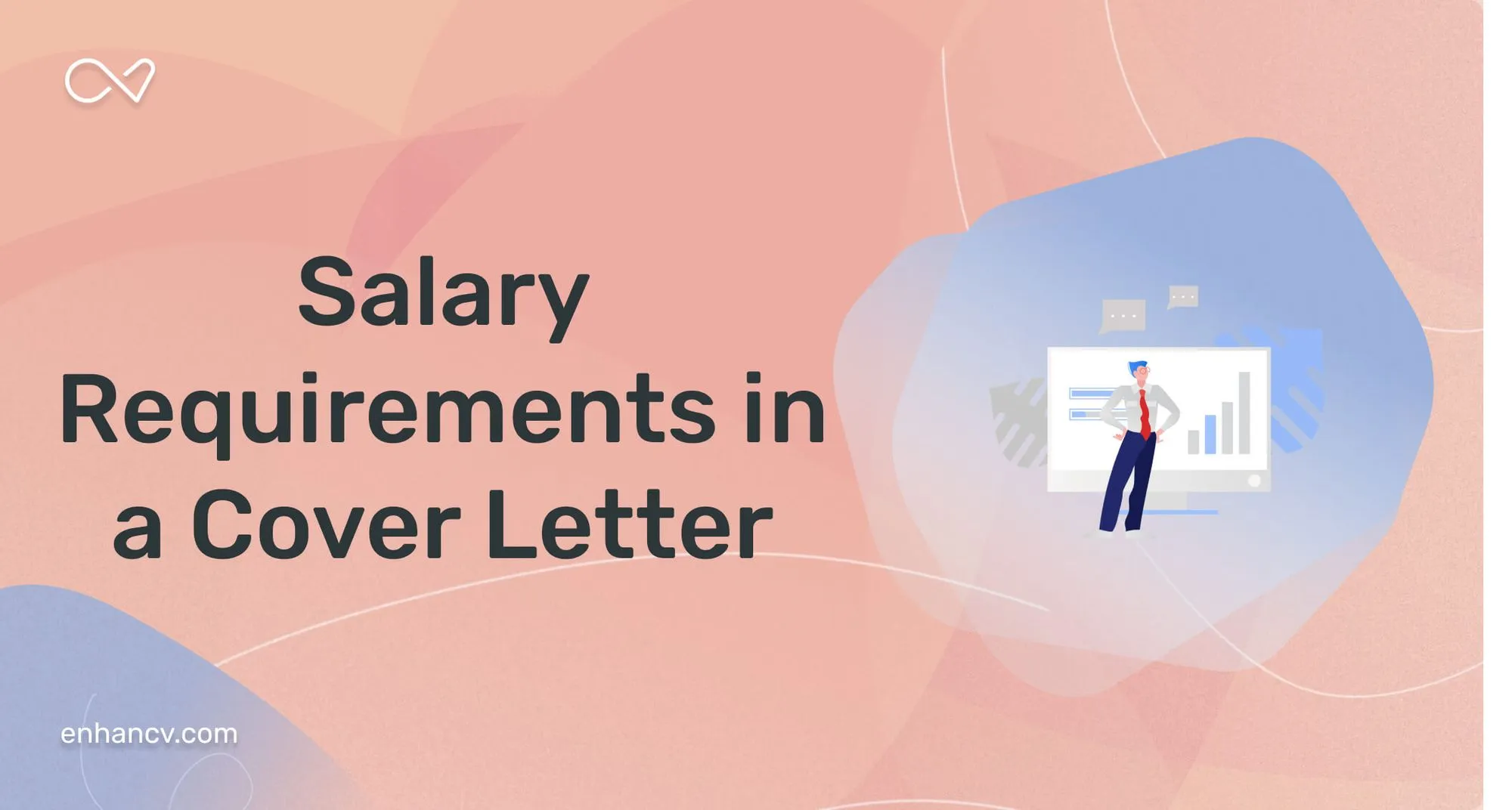
The opening paragraph is your chance to make a strong first impression. Start with a concise and engaging statement that captures the reader’s attention. Clearly state the position you are applying for and how you learned about the opportunity. Briefly mention something specific that interests you about the company or the role. To make a memorable opening, personalize the message and show your enthusiasm. Do not simply restate information found in the job posting; instead, show how you’ve researched the company and understand their needs. Make sure the opening paragraph is relevant to the job and clearly conveys your purpose for writing the cover letter. A well-crafted opening will make the reader want to continue reading and learn more about you.
Highlighting Your Skills and Experience
This section is the core of your cover letter, where you demonstrate your value to the potential employer. Focus on highlighting the skills and experiences that are most relevant to the job description. The key is to tailor your responses to the job requirements, using the same keywords and phrases used in the job posting. Structure this section into one or two paragraphs, each addressing specific skills or experiences. Provide concrete examples of your accomplishments and quantify your results whenever possible. Show the impact you made in previous roles using action verbs and specific data. Keep your focus on the employer’s needs, demonstrating how your skills and experiences align with the job requirements. This section should provide a compelling narrative that proves your qualifications.
Matching Skills to the Job Description
Carefully review the job description and identify the key skills and requirements. Use the same keywords and phrases in your cover letter. Describe how your skills align with the job requirements by providing specific examples. This shows the hiring manager that you understand the role and are a good fit. Your aim is to demonstrate that you possess the skills and experience necessary to perform the job effectively. Do not just list your skills; demonstrate how you’ve used those skills in past roles and the results you achieved. Customization is key; tailor your examples to match the specific needs of the role you are applying for. This helps the hiring manager to quickly see the connection between your abilities and the job requirements.
Quantifying Your Achievements
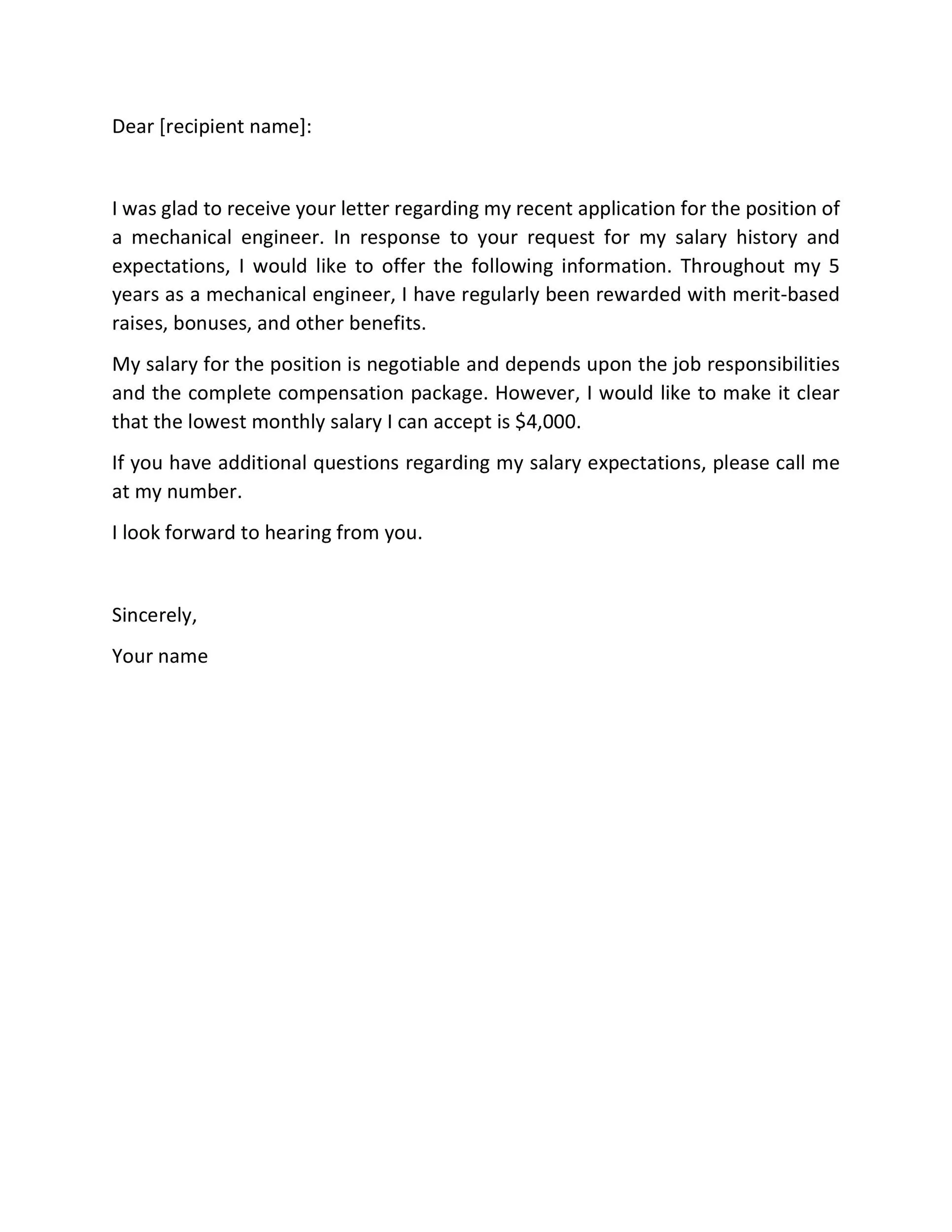
Instead of simply stating your responsibilities, quantify your achievements with data and metrics. Quantifiable results provide concrete evidence of your abilities and the value you bring to a company. Use numbers to illustrate your impact, such as the percentage increase in sales, the number of projects completed on time, or the amount of money saved. Whenever possible, measure and report your accomplishments with specific figures. Include the results you achieved in previous roles using concrete numbers to highlight your skills. Quantifying your achievements makes your claims more credible and shows employers the tangible benefits of hiring you. This section should demonstrate your ability to deliver results and contribute to the company’s bottom line.
Showcasing Your Personality
Your cover letter is an opportunity to showcase your personality and passion for the role. Infuse your cover letter with a tone that reflects your enthusiasm and genuine interest in the opportunity. Use positive and energetic language to demonstrate your excitement about the position and the company. Maintain a professional tone, but avoid sounding robotic or overly formal. Use anecdotes and examples that highlight your personality and work style. Show what makes you unique and how your personality aligns with the company culture. Your personality can help you stand out from other applicants and create a memorable impression. Being authentic and showing your personality can make your cover letter more engaging and help you build a stronger connection with the hiring manager.
Addressing Salary Requirements
Addressing salary requirements is an important part of the cover letter, especially if the job posting specifically requests it. When you have clear salary expectations, it’s crucial to address them thoughtfully. If the job posting asks for your salary expectations, you should include them in your cover letter. Failing to do so could cause your application to be automatically discarded. If the job posting does not mention salary, then you have the option to address it or not. If you are unsure, research the salary range for similar positions in your area and industry. When addressing salary, be clear, concise, and professional. Your goal is to provide the employer with the information they need while maintaining a positive and confident tone. This will help prevent any misunderstandings and ensure that both you and the employer are aligned on expectations.
How to State Your Salary Expectations
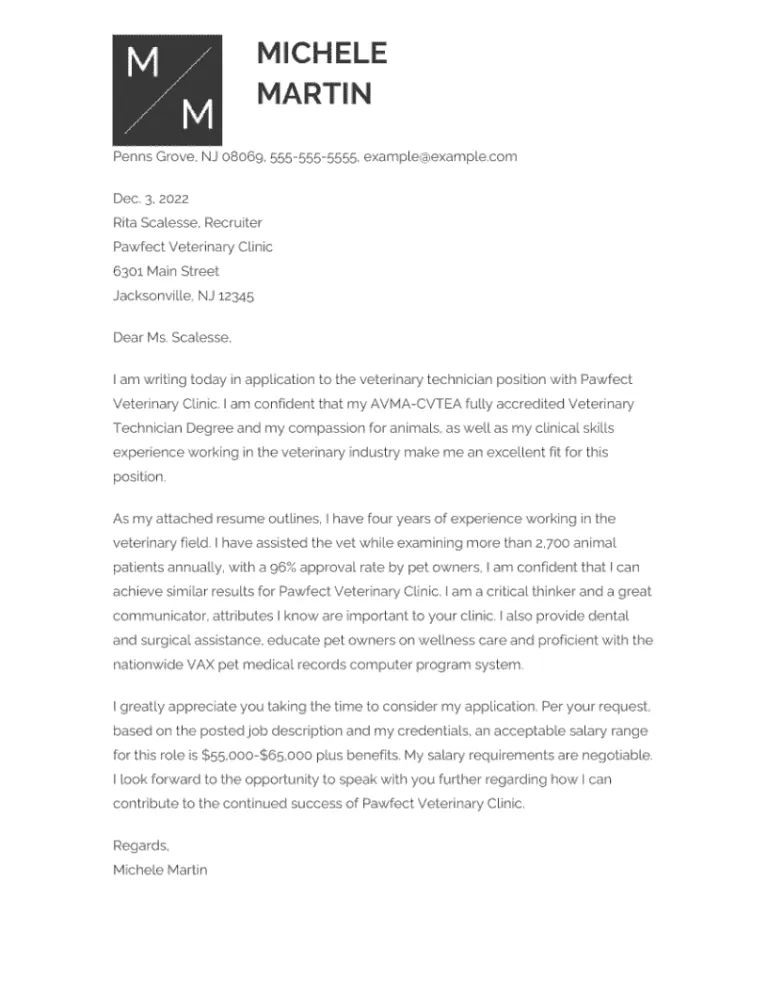
Be direct and clear when stating your salary expectations. Provide a specific salary or a salary range. When possible, it’s often better to provide a salary range instead of a single number. Provide a range that reflects your research of industry standards. This shows your flexibility and allows for some negotiation. If you are unsure of the specific salary, research the average salary for the position in your geographic area and adjust the range accordingly. Be realistic about your worth and avoid undercutting yourself. However, be prepared to negotiate, and be willing to discuss your expectations during the interview process. Make sure the range reflects your skills, experience, and the value you bring to the role. Keep your tone positive, confident, and professional.
Salary Range vs. Specific Number
Deciding whether to provide a specific number or a salary range depends on the job posting and your comfort level. Providing a salary range typically gives you more flexibility during negotiations. Research industry standards and salary data to determine an appropriate range. Consider factors such as experience, education, and the specific requirements of the job. A well-researched salary range demonstrates that you have a good understanding of the market. If the job posting requests a specific salary, it’s usually best to comply with the request. If you have a firm understanding of your desired salary, providing a specific number can also be acceptable. Base your decision on the specific circumstances and your overall negotiation strategy. The approach you choose should position you in the best light while still being transparent and professional.
Negotiating Salary in Your Cover Letter
Your cover letter can be a starting point for salary negotiation. However, it’s best to keep salary negotiations relatively brief at this stage. Be clear about your expectations, but also show that you are open to discussion. In your cover letter, you can state your desired salary or range and add a statement such as ‘I am open to discussing this further during the interview process.’ This opens the door for a more detailed conversation later. Focus your efforts on selling yourself, the value you bring, and why you are the best candidate for the job. Negotiation is more effective when you can demonstrate your worth and how you meet the needs of the employer. By showing your willingness to negotiate, you create a more collaborative environment and increase the likelihood of reaching a mutually beneficial agreement.
The Closing Paragraph: Call to Action
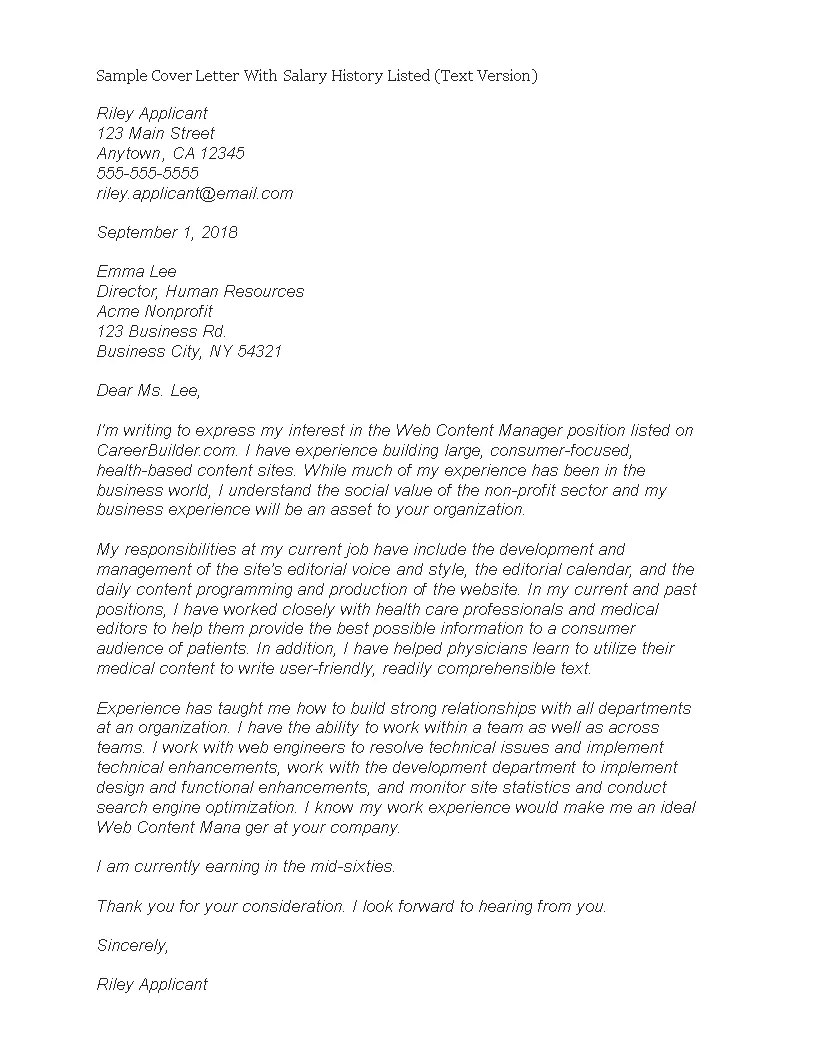
The closing paragraph is your last chance to make a lasting impression. Summarize your key qualifications and restate your interest in the position. Express your enthusiasm and reiterate your value to the company. Include a clear call to action, such as requesting an interview or indicating your availability for a phone call. Make it easy for the hiring manager to take the next step. End with a professional closing, such as ‘Sincerely’ or ‘Best regards,’ followed by your name. This closing paragraph should leave a positive impression and encourage the hiring manager to contact you.
Expressing Your Enthusiasm
Expressing enthusiasm is key to making a positive impression. Reiterate your excitement about the position and the company. Show that you have researched the company and are genuinely interested in the opportunity. Highlight specific aspects of the role or the company’s mission that excite you. Tailor your enthusiasm to the specific job and company. Your enthusiasm is infectious, so it can make the hiring manager want to learn more about you. Your enthusiasm can demonstrate your passion for the role and your eagerness to contribute to the company’s success.
Thanking the Reader
Always thank the reader for their time and consideration. A simple ‘Thank you for your time and consideration’ demonstrates your respect for their efforts. This gesture shows your professionalism and appreciation. It helps to end the cover letter on a positive note, regardless of whether you get an interview. Make sure your thanks are genuine and sincere. This small act can leave a lasting positive impression and increases your chances of moving forward in the hiring process. It also reinforces that you appreciate their effort.
Formatting and Proofreading Your Cover Letter
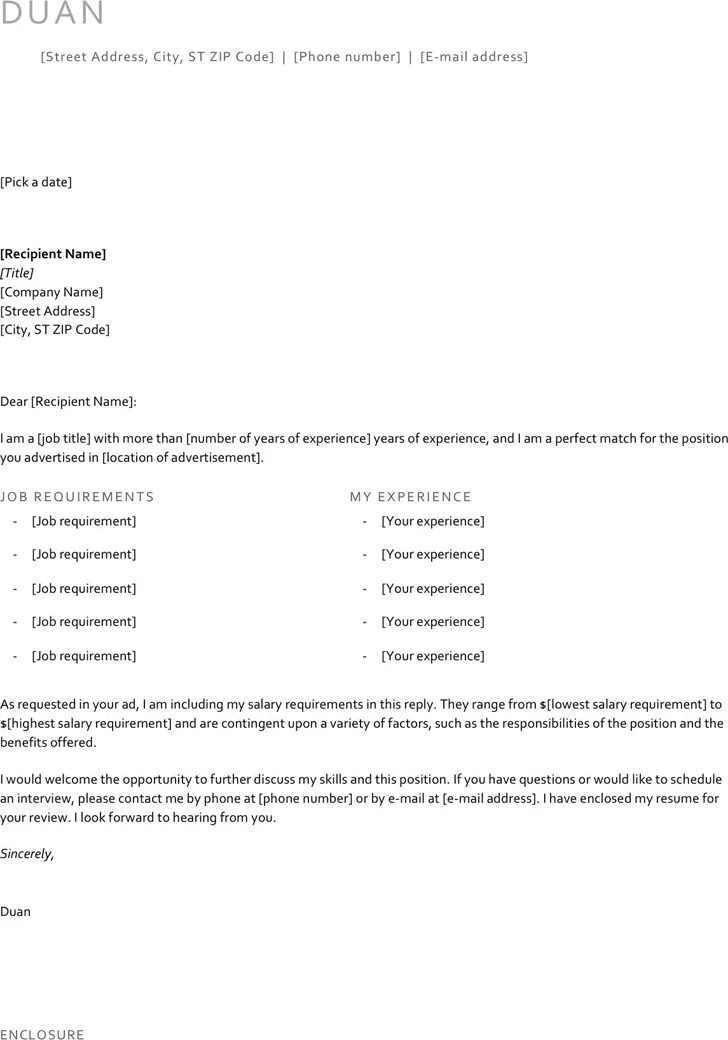
The formatting and proofreading of your cover letter is just as important as its content. A polished and error-free cover letter demonstrates professionalism and attention to detail. Poor formatting and errors can detract from your message and give the impression that you are not serious about the job. The formatting and proofreading stage is your final opportunity to make sure your cover letter looks professional and presents you in the best possible light. Take the time to carefully review your cover letter to catch any mistakes before sending it to the employer. Proper formatting will make your cover letter easy to read. Proofreading will ensure that it is free of any errors.
Formatting Tips for Readability
Make your cover letter easy to read by using clear and concise formatting. Use a professional font such as Times New Roman, Arial, or Calibri. Maintain a consistent font size, usually between 10 and 12 points. Use single or 1.15 line spacing and a standard margin of one inch on all sides. Use bullet points to highlight key skills and accomplishments. Make sure the text is easy to read. A well-formatted cover letter is more likely to be read thoroughly. Make sure your cover letter is properly spaced and aligned, and use headings and subheadings to break up large blocks of text. Make sure your formatting is consistent throughout the document. A clean and organized format will make your cover letter more readable and improve the overall impression.
Proofreading for Errors
Proofreading is essential to eliminate any errors that can damage your credibility. Carefully proofread your cover letter for typos, grammatical errors, and spelling mistakes. Run a spell check, but do not rely on it entirely. Read the letter aloud to catch awkward phrasing or sentences that do not make sense. Ask a friend or colleague to review your cover letter as a second pair of eyes. Make sure your name, address, and contact information are correct. Errors show that you did not pay attention to detail and might make the hiring manager question your professionalism. A final review will ensure your cover letter looks polished and professional before you submit it.
Cover Letter Templates and Examples
Using templates and examples can be very helpful when creating a cover letter. They give you a starting point and guide you in creating your own. Numerous resources offer free and premium cover letter templates that can save you time and ensure you include all the essential elements. However, it’s important to customize any template you use to reflect your individual experience and the specific job requirements. Templates are great for structure, but customization is vital. A well-customized cover letter will show that you have thought about the company and the role and will provide a good impression.
Where to Find Templates
There are many places where you can find cover letter templates. Use online job search sites, career websites, and resume-building services. Many of these services offer templates for different industries and job types. Look for templates designed to reflect specific industries. Search for templates that are relevant to your field. You can also find templates on professional design websites. Always choose a template that you feel comfortable with and that matches your style. Ensure the templates are well-structured, easy to use, and designed to highlight your skills and experiences. Consider your industry, the job, and the company’s culture. Use templates from reputable sources and customize them to make them your own.
Customizing Templates for Your Needs
Templates are great for structure, but it is essential to customize them to reflect your personal experiences. Tailor the template to fit your individual experiences. Do not use generic templates. Adjust the language to match the specific requirements of the job description and the company culture. Modify the template to fit your specific experiences and highlight the most relevant skills for the role. Customize the template to reflect your personality and writing style. The best cover letter templates are those that provide a framework for you to express your unique qualifications. A well-customized template will help you stand out.
Avoiding Common Cover Letter Mistakes
There are several common mistakes to avoid when writing a cover letter. These errors can undermine your chances of getting hired and can have a lasting negative impression. Avoid making errors that can decrease your chances of getting an interview. Be aware of some key things to avoid, and make sure you are not making mistakes. Take the time to identify potential mistakes, and then carefully proofread your cover letter to avoid these common errors. Be aware of some common mistakes that can hurt your chances of getting an interview.
Typos and Grammatical Errors
Typos and grammatical errors are unacceptable in cover letters. Proofreading your cover letter is essential to ensure that it’s polished and professional. Typos, spelling errors, and grammatical mistakes can make you look careless and unprofessional. Run a spell check and grammar check, but do not rely on them entirely. Read your cover letter aloud to catch any awkward phrasing or sentences. Have someone else review your cover letter for errors and feedback. Even a small mistake can detract from your credibility and make you look less qualified. Check and recheck everything before submitting your application. Typos and grammatical errors create a negative impression.
Generic Content
Avoid using generic content. Generic cover letters are not effective because they do not demonstrate your unique qualifications. Tailor each cover letter to match the specific job description and the company’s needs. Avoid sending the same cover letter to multiple job applications. Your cover letter needs to reflect your personality and your genuine interest in the position. When writing your cover letter, show the hiring manager that you’ve taken the time to understand the role and the company’s culture. The best cover letters are customized to highlight your qualifications in ways that demonstrate your understanding of the job. Your cover letter should be specific and relevant to the role you are applying for.
Ignoring the Job Description
Ignoring the job description is one of the worst mistakes you can make when writing a cover letter. The job description contains the key requirements the employer is looking for. Make sure you are carefully reviewing the job description to identify the essential skills, qualifications, and experiences. Tailor your cover letter to align with the job description by using the same keywords and phrases. Highlight how your skills and experiences match the employer’s needs. Show how you meet the requirements outlined in the job posting. Ignoring the job description shows that you are not serious about the job or that you lack attention to detail. Always address the job description to ensure your cover letter is relevant and effective.
Submitting Your Cover Letter
Once you’ve written and proofread your cover letter, ensure that you submit it correctly. The submission process often involves paying attention to the file format and naming conventions and following the instructions provided in the job posting. Adhering to these guidelines will showcase your professionalism and attention to detail. Following all submission guidelines ensures your application is considered and demonstrates your willingness to follow instructions. Paying attention to these details demonstrates that you have taken the time to prepare your application carefully.
File Format and Naming Conventions
Always submit your cover letter in the correct file format. Unless otherwise specified, save your cover letter as a PDF. The PDF format preserves your formatting and ensures that your cover letter looks the same on any device. Use a clear and professional file name, such as ‘YourName_CoverLetter.pdf.’ Avoid using special characters or spaces in your file name. Double-check to ensure that you have named and formatted your cover letter correctly. If you do not do so, your application may not be considered. Following these guidelines ensures that the hiring manager can easily open and review your cover letter.
Following Instructions
Read the job posting and carefully follow all instructions. Some postings may specify how to submit your cover letter. If the instructions request the cover letter be sent as an email attachment, do so. If they specify a specific format or a specific name, follow the instructions. When submitting your cover letter, be sure to follow all instructions. Failing to follow instructions can indicate that you do not pay attention to detail or that you are not serious about the job. Adhering to the submission instructions also reflects your professionalism. Ignoring instructions can be a common reason why applications are rejected. Always be sure to follow the instructions.
In conclusion, a well-crafted cover letter is a powerful tool in your job search. By following these strategies, you can create a compelling cover letter that captures the hiring manager’s attention. Make sure that you customize each cover letter and ensure the formatting and the proofreading are perfect. Make it clear that you’re the best candidate and boost your chances of getting hired!
